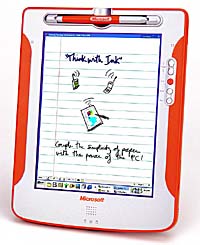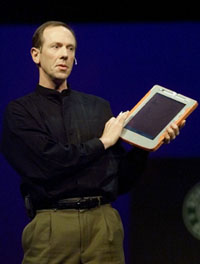LAS VEGAS, Nov. 13, 2000 — Last night in his Comdex/Fall 2000 keynote address, Microsoft Chairman Bill Gates demonstrated a prototype of a Tablet PC, a major evolutionary step in PC functionality and usability. To find out more about the Tablet PC and the future of tablet-based computing, PressPass spoke with Alexandra Loeb, general manager of Microsoft’s Tablet PC effort.

This Tablet PC prototype developed by Microsoft demonstrates the concept of tablet computing.
PressPass: What exactly is a Tablet PC?
Loeb: First and foremost, the Microsoft vision for a Tablet PC is that it’s a full Windows computer. It runs all of your familiar productivity applications such as Word, Excel and PowerPoint, and offers the same rich connectivity to the Internet that you expect from your desktop or notebook PC. What the Tablet PC adds is the simplicity of pen and paper. Because you can write on the screen, it’s optimized for tasks that are very common in business computing — like taking notes at a meeting or annotating a document, or for immersive reading.
PressPass: So it’s not just a companion device or a digital appliance?
Loeb: When we looked at what made the most sense for customers, it was clear that a Tablet PC needed to be
the primary PC. This
means that you can have your email and calendar, your project files, or even complete databases with you at all times. And there are no compromises: you don’t need to sync or port your Windows applications, and
you retain the
full
fidelity of data with no loss of formatting.
At the same time, we also see a great future for Pocket PCs, smart phones and Internet appliances among users who need extreme portability. The Tablet PC is designed to work well with all of those devices, but it’s targeted at business computer users who spend some part of their day away from their desks but could benefit from having their PC move with them.
PressPass: What operating system will the Tablet PC run? Is it an embedded system?
Loeb : What Bill Gates demonstrated at Comdex was the next version of Windows, code-named Whistler. It’s not an embedded operating system (OS) running out of Read-Only Memory (ROM)–Tablet PCs will have more than sufficient RAM to run a full desktop OS.

Microsoft software architect Bert Keely shows a prototype of the Tablet PC during Bill Gates’ keynote at COMDEX/Fall 2000.
PressPass: Beyond simple handwriting recognition, how will Tablet PC users be able to work with what they write on-screen?
Loeb : Our handwriting recognition is impressive, but
the
initial success of the Tablet PC is not dependent on “perfect” handwriting recognition.
We see great value in treating “ink as ink” — allowing people to revise, edit, and re-purpose their handwritten notes after they’ve written them on the computer screen using the stylus.
We call it
“treating ink as a first class citizen,”
so that pen input is equal in flexibility and power to input from a mouse or keyboard. We want the PC to adapt to the way that individuals work, not the other way around.
So that means allowing handwritten notes to remain as ink, and then building in the capabilities to make changes, and even index and search on ink while it remains in ink format.
And, of course, the Tablet PC
will support great conversion of ink to text as well.
PressPass: What kinds of things can users do on the Tablet PC that they can’t do on a current notebook?
Loeb : Well, to begin with, you can balance it in one hand — it will be about the size of a writing tablet. It will weigh less than your current laptop, and it will be incredibly useful when you are away from your desk and in a meeting. Our note-taking application literally comes up as a sheet of paper, and you just start writing. But what digital ink offers in addition is the ability to move, highlight, save, sort and search those handwritten notes. How many times have all of us had to go back to paper-based notes from a meeting and scribble in the margin, or draw arrows to show where we really wanted to insert something? The Tablet PC allows you to actually manipulate that text — you don’t need to rewrite all the notes around it — and it gives you some very powerful new ways to share information and collaborate via email or the Internet. The integration with your key productivity applications extends the benefits of the paper metaphor in many, many ways.
PressPass: Microsoft and other companies have made forays into tablets or pen-based computers before. How is the Tablet PC different from earlier approaches?
Loeb : Three
major things have changed. First,
key technologies — such as battery life,
display resolution, handwriting recognition, and memory — have
all advanced substantially.
Second, we have the benefit of the experience gained from the past. Relative to our own Pen Windows initiative in the mid-1990s, for example,
we’ve learned to look at the complete user experience rather than simply building support for the pen into the operating system. We are evaluating the Tablet PC from the customers’ perspective rather than from the OS developer’s perspective. It’s not a computer science problem we’re trying to solve — it’s a customer problem. Third, the
added component of wireless communications makes mobility a key element in all future computing scenarios, so the Tablet PC
provides greater
mobile functionality to corporate computing.
PressPass: What wireless standards will the Tablet PC support?
Loeb : We’ll support 802.11 and eventually Bluetooth or any broadly supported wireless standard. We’re excited about what wireless connectivity can mean for real-time updates and collaboration — not only for the meeting you’re in at that moment, but for broader, inter-group or inter-office scenarios.
PressPass:
When
will Tablet PCs be available?
Loeb : Our goal is to have Tablet PCs available in 2002.
The specific timing depends upon both our own testing and software development, and also the design and production schedules of the original equipment manufacturers (OEMs) that will be our partners in this initiative. We are not in the hardware business — the final decisions will really be made by the OEMs.
We expect that OEMs will want to implement their own unique hardware designs. We’re excited by the initial reactions we’re getting from OEMs.
PressPass: How much will they cost?
Loeb : It’s too early to tell. Again, each OEM will determine its pricing strategy. But since they are full-function PCs, they’re more likely to be priced in that range than as lower-cost appliances.
PressPass: Will customers buy Tablet PCs with a docking station, external keyboard and even a larger monitor?
Loeb : That’s one scenario, but we expect many variations on the basic concept of the Tablet PC.
Press Pass: How will application developers be able to take advantage of the Tablet PC?
Loeb : As we get closer to finalizing the elements of the Tablet PC, we will work with software developers to make sure they have the information and support they need to make their applications
“pen-aware.”
This will allow them to take full advantage of digital ink and pen capabilities and optimize their software for the Tablet PC form factor, which is portrait-based and focused on a very low-clutter user interface. We’ll have development kits and the usual range of tools and technical help for the software community.
PressPass: How does the Tablet PC fit into Microsoft’s .NET strategy?
Loeb : We think the Tablet PC will be a great platform for .NET because it gives users the best of both worlds. Since it’s a fully functional PC, it can run a wider range of software and services than other mobile devices — for example, a smart phone won’t be able to host a SQL database, but the Tablet PC can. Yet, as a mobile device, the Tablet PC still supports the .NET vision of making information available to users any time, any place and on any device.




